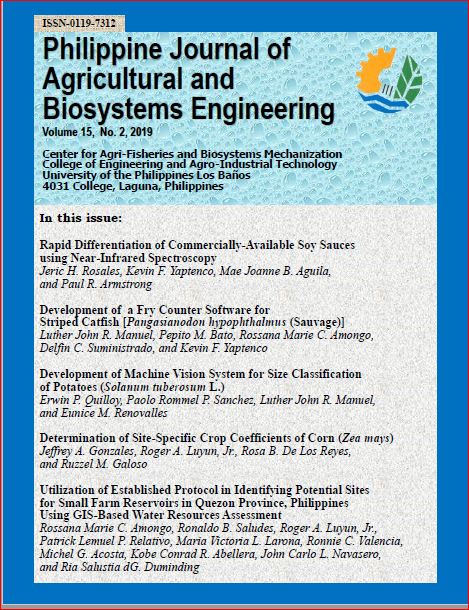Utilization of Established Protocol in Identifying Potential Sites for Small Farm Reservoirs in Quezon Province, Philippines Using GIS-Based Water Resources Assessment
Abstract
The determination of appropriate locations for irrigation development is essential to achieve optimum water use and land productivity. The conventional approach in identifying potential sites for irrigation projects is tedious and time consuming. A modern and reliable water resources assessment model is thus needed. A GIS-based water resources assessment model for identifying suitable sites for Small Farm Reservoirs (SFR) was developed for optimum water resource allocation and utilization in Quezon Province. The study is part of the Department of Agriculture-Bureau of Agricultural Research (DA-BAR) project on Identification of Potential Sites for Small-Scale irrigation Projects (SSIPs) in CALABARZON. Primary data collection was conducted through needs and design assessment questionnaires for SFR, and geo-tagging application using mobile devices. Location maps of existing SFRs and potential sites for development of other SSIPs in the province were also generated. The three factors considered in site suitability mapping of SFR were (a) average annual rainfall, (b) slope and (c) soil texture of the area. The developed methodology was found useful in identifying optimal locations for SFR development in Quezon Province. Based on the protocol established, of the total 455,144 hectares for SFR development in Quezon Province, 14% was classified as highly suitable, 80% were classified as moderately suitable, and only 6% were categorized as marginally suitable. Such information is vital for agricultural irrigation planning and development using SFRs.
Citation:
AMONGO, R. M., SALUDES, R., LUYUN, R., JR., RELATIVO, P. L., LARONA, M. V., VALENCIA, R., ACOSTA, M., ABELLERA, K. C., NAVASERO, J. C., & DUMINDING, R. S. (2019). Utilization of Established Protocol in Identifying Potential Sites for Small Farm Reservoirs in Quezon Province, Philippines Using GIS-Based Water Resources Assessment. Philippine Journal of Agricultural and Biosystems Engineering, 15(2), 43–54. https://doi.org/10.48196/015.02.2019.05


